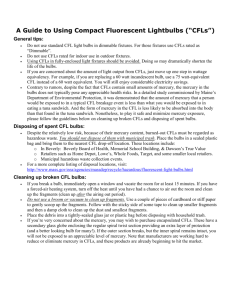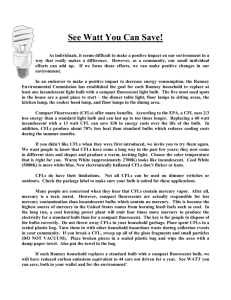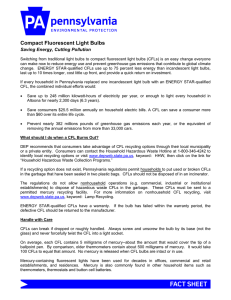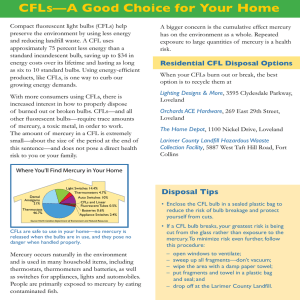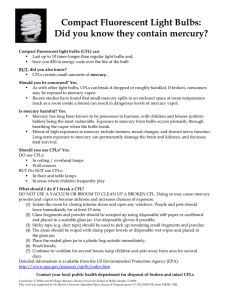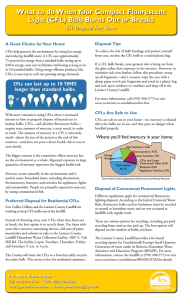Compact Fluorescent Light Bulbs (CFLs)
advertisement
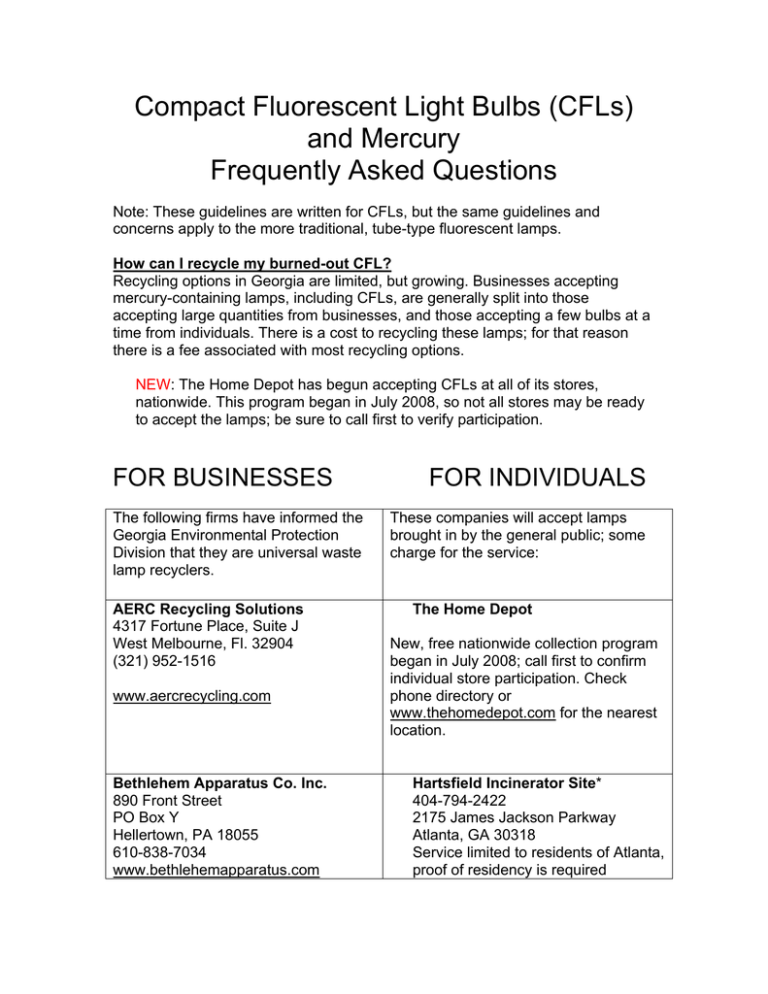
Compact Fluorescent Light Bulbs (CFLs) and Mercury Frequently Asked Questions Note: These guidelines are written for CFLs, but the same guidelines and concerns apply to the more traditional, tube-type fluorescent lamps. How can I recycle my burned-out CFL? Recycling options in Georgia are limited, but growing. Businesses accepting mercury-containing lamps, including CFLs, are generally split into those accepting large quantities from businesses, and those accepting a few bulbs at a time from individuals. There is a cost to recycling these lamps; for that reason there is a fee associated with most recycling options. NEW: The Home Depot has begun accepting CFLs at all of its stores, nationwide. This program began in July 2008, so not all stores may be ready to accept the lamps; be sure to call first to verify participation. FOR BUSINESSES The following firms have informed the Georgia Environmental Protection Division that they are universal waste lamp recyclers. AERC Recycling Solutions 4317 Fortune Place, Suite J West Melbourne, Fl. 32904 (321) 952-1516 www.aercrecycling.com Bethlehem Apparatus Co. Inc. 890 Front Street PO Box Y Hellertown, PA 18055 610-838-7034 www.bethlehemapparatus.com FOR INDIVIDUALS These companies will accept lamps brought in by the general public; some charge for the service: The Home Depot New, free nationwide collection program began in July 2008; call first to confirm individual store participation. Check phone directory or www.thehomedepot.com for the nearest location. Hartsfield Incinerator Site* 404-794-2422 2175 James Jackson Parkway Atlanta, GA 30318 Service limited to residents of Atlanta, proof of residency is required *This is not an active incinerator, lamps collected here are recycled Cleanlites Recycling, Inc. 100 Fine Road Spartanburg, SC 29303 864-503-9900 www.cleanlites.com Atlanta Light Bulbs 2109 Mountain Industrial Blvd. Tucker, GA 30084 770-491-3586 Earth Protection Services, Inc. 102 Twenty-nine Court Williamston, SC 29697 864-847-7700 www.earthpro.com IKEA 441 16th Street Atlanta, GA 30363 404-745-4532 Environmental Light Recyclers 2737 Bryan Avenue Fort Worth, TX 76104-6716 817-924-9381 steve.remley@lightrecyclers.com City of Atlanta E-Waste collections (3rd Saturday of each month only) Grady High School Parking Lot Eighth Street, Atlanta 8 a.m. – 4 p.m. Green Lights Recycling Inc. 4149 Main St. Loris, SC 29560 843-251-8308 www.greenlightsrecycling.com HTR-GROUP 415 Kaiser Ind. Dr. Kaiser, MO 65047 888-537-4874 www.htr-group.com MKC Enterprises Doraville, GA. 770-457-1341 LEI 46257 Morris Road PO Box 2962 Hammond, LA 70404-2962 800-309-9908 www.lei-inc.net EnviroTech Environmental Services 161 Andrew Drive Stockbridge, GA 30281 770-506-8292 Southeast Recycling Technologies, Inc. 2260 Moon Station Court, Suite 140 KENNESAW, GA 30144 Contact: Richard Hall Email: srtrichard@bellsouth.net Phone: 770-426-5000 Fax: 770-426-4441 Lighting Resources LLC. 5703 W. Sligh Ave. Tampa, FL 33634 866-961-9100 www.lightingresourcesinc.com Veolia Environmental Service 342 Marpan Lane Tallahassee, FL 32305 850-877-8299 www.veoliaes.com Southeast Recycling, Inc. 906 Chase Drive Johnson City, TN 37604 800-592-3970 www.recyclebulbs.com USA Lamp and Ballast 7806 Anthony Wayne Blvd. Cincinnati, OH 45216 800-778-6645 www.usalamp.com These companies will provide a pre-paid shipping package to collect CFLs. Details and prices vary, and are detailed on their respective Web sites. www.wmlamptracker.com (This service also provides for collection of mercury-containing devices such as batteries, thermostats, thermometers and elemental mercury.) http://veoliaes-sw.com/RecyclePak%20Uses Revised: July 14, 2008 This list represents recycling options known to the State of Georgia, and may not be inclusive, nor are these companies endorsed by the State of Georgia. If you know of recycling options not included on this listing, please send an e-mail to recycle@dca.state.ga.us Why should people use CFLs? Switching from traditional light bulbs to CFLs is an effective, accessible change every American can make right now to reduce energy use at home and prevent greenhouse gas emissions that contribute to global climate change. Lighting accounts for close to 20 percent of the average home’s electric bill. ENERGY STAR qualified CFLs use up to 75 percent less energy than incandescent light bulbs, last up to 10 times longer, cost little up front, and provide a quick return on investment. If every home in America replaced just one incandescent light bulb with an ENERGY STAR qualified CFL, in one year it would save enough energy to light more than 3 million homes and prevent greenhouse gas emissions equivalent to those of more than 800,000 cars. Do CFLs contain mercury? Yes. CFLs contain a very small amount of mercury sealed within the glass tubing – an average of 5 milligrams – about the amount that would cover the tip of a ball-point pen. By comparison, older thermometers contain about 500 milligrams of mercury. Mercury currently is an essential component of CFLs and is what allows the bulb to be an efficient light source. No mercury is released when the bulbs are intact or in use. Many manufacturers have taken significant steps to reduce mercury used in their fluorescent lighting products. What is mercury? Mercury is an element (Hg on the periodic table.) Mercury emissions in the air can come from both natural and man-made sources. Mercury exposure can cause severe neurological damage in humans, especially children and pregnant women. Coal-fired power plants are the largest man-made source because mercury that naturally exists in coal is released into the air when coal is burned to make electricity. Coal-fired power generation accounts for roughly 40 percent of the mercury emissions in the U.S. Using CFLs reduces the amount of mercury entering our environment, even if the used bulb is landfilled instead of recycled. That’s because electricity in Georgia is largely generated by coal-burning power plants, which emit mercury. The energy saved by using CFLs reduces more mercury from power plants than the bulbs contain, resulting in a net reduction of mercury entering our environment. What precautions should I take when using CFLs in my home? CFLs are made of glass and can break if dropped or roughly handled. Be careful when removing the bulb from its packaging, installing it, or replacing it. Always screw and unscrew the lamp by its base (not the glass), and never forcefully twist the CFL into a light socket. If a CFL breaks in your home, follow the clean-up recommendations below. Used CFLs should be disposed of properly (see below). What should I do with a CFL when it burns out? If you cannot find a convenient location to recycle your used CFL (see table above) or if it has broken, seal the bulb in two plastic bags and put it into the outside trash, or other protected outside location, for the next normal trash collection. ENERGY STAR qualified CFLs have a warranty. If the bulb has failed within the warranty period, return it to your retailer. How should I clean up a broken fluorescent bulb? The following steps can be performed by the general public: 1. Open a window and leave the room for 15 minutes or more. 2. Carefully scoop up the fragments and powder with stiff paper or cardboard and place them in a sealed plastic bag. • Use disposable rubber gloves, if available (i.e., do not use bare hands). Wipe the area clean with damp paper towels or disposable wet wipes and place them in the plastic bag. • Do not use a vacuum or broom to clean up the broken bulb on hard surfaces. 3. Place all cleanup materials in a second sealed plastic bag. • Place the first bag in a second sealed plastic bag and put it in the outdoor trash container or in another outdoor protected area for the next normal trash disposal. • Wash your hands after disposing of the bag. 4. If a fluorescent bulb breaks on a rug or carpet: • First, remove all materials you can without using a vacuum cleaner, following the steps above. Sticky tape (such as duct tape) can be used to pick up small pieces and powder. • If vacuuming is needed after all visible materials are removed, vacuum the area where the bulb was broken, remove the vacuum bag (or empty and wipe the canister) and put the bag or vacuum debris in two sealed plastic bags in the outdoor trash or protected outdoor location for normal disposal. This information was compiled by the Georgia Department of Community Affairs, in conjunction with the Georgia Environmental Protection Division, Pollution Protection Assistance Division, Georgia Environmental Facilities Authority and federal Environmental Protection Agency and Energy Star program.

